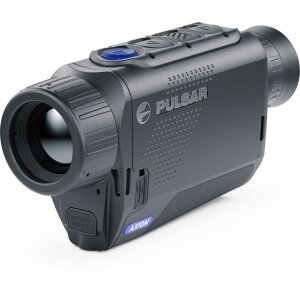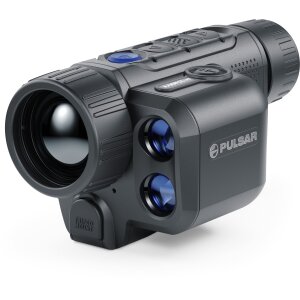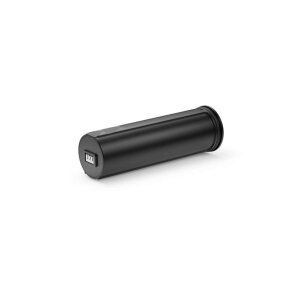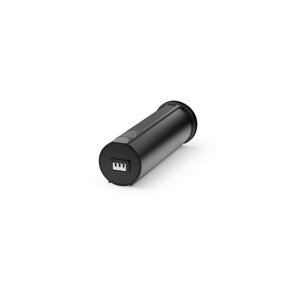Pulsar Merger LRF XP50 thermal imaging camera with integrated laser rangefinder
The Merger LRF XP50 from Pulsar has the classic design of a daylight binocular and is characterised by its small size, external aesthetics and exemplary ergonomics. The Pulsar Merger LRF, with its variable 2.5x to 20x magnification, is equipped with a high-sensitivity, high-performance 640x480 17µm thermal image sensor (NETD <25mK) that ensures detail detection up to 1200 metres, even in the most challenging conditions. Whether it's rain, snow, fog, high waves or waterways, the IPX7 rating ensures that the Pulsar Merger LRF will not fail in the harshest weather conditions. With a thermal imager, unlike a night vision device, objects can also be detected which are obscured by bushes, tall grass or branches, for example. Moreover, the thermal imaging camera does not need any additional lighting.
A built-in precision laser range finder (LRF), which can detect distances up to 1000 metres, allows distance measurement as a single measurement or in continuous scan modes. The laser rangefinder of the Merger LRF has a tremendous accuracy, which enables fast and error-free target acquisition.
The highly sensitive microbolometer detects minimal temperature differences under conditions of low temperature contrast as well as in rain or fog. A fast F50/1.0 germanium lens, along with the advanced sensor, 8 colour palette options and AMOLED display, provide exceptional detection and identification capabilities.
Two independent batteries provide up to 10 hours of continuous operation on a single charge. The Merger thermal imager comes standard with integrated video and photo recording and 16GB of built-in storage. The Merger's enhanced Wi-Fi connectivity with support for the 2.4/5 GHz band enables seamless connectivity with the Stream-Vision 2 app, available for both Android and iOS devices.
Compact size, classic design
The Merger LRF thermal binoculars from Pulsar feature the classic design of daylight binoculars. With its small form factor, these thermal imaging binoculars fit comfortably in the hand, yet offer appealing external aesthetics and exemplary ergonomics. The six function buttons are located in the convenient access zone and the most commonly used instrument functions can be activated with a single touch.
Comfortable viewing experience
The optical design of the Merger LRF thermal imager is fully attuned to the nature of human vision. Naturally, a person takes in information from vision through two visual channels simultaneously. Seeing with two eyes is less tiring than seeing with only one eye. This means better detection of small or faint objects and better performance in low-contrast scenarios than comparable monocular thermal imagers of the same technical level. The Merger LRF's interpupillary distance is adjustable from 62 to 74 mm to suit the individual user's needs.
Integrated precision laser rangefinder
In order to make the right decisions, it is important to accurately estimate the distance of the target. A built-in laser rangefinder (LRF) with a range of up to 1 kilometre lets you measure the distance in single measurement and continuous scan modes with an accuracy of ± 1 metre, allowing you to assess the situation quickly and without error.
High resolution thermal imager with 640x480 pixels @ < 25 mK NETD sensor
The newly developed 17µm thermal image sensor with a thermal sensitivity (NETD) of <25mK has a high resolution of 640x480 pixels and guarantees perfectly detailed object imaging at 50Hz, even under the most adverse weather conditions with small temperature differences. The high optical sensor resolution makes the smallest objects, i.e. branches, leaves, body parts of an animal, appear particularly sharp and clear against the background. The high thermal sensitivity (NETD) ensures that even the smallest temperature differences can be distinguished by the infrared camera, even in rain, fog or dew on cold mornings.
Fast lens F50/1.0
The properties of the thermal imaging lens have a decisive influence on the ability of a thermal imaging device to detect thermal radiation with the lowest possible radiation level. Combined with the highly sensitive sensor, the fast lens provides the highest detection efficiency. In rain or fog, when the temperature contrast of the observed objects is minimal, the Merger LRF always provides the user with a high quality, detailed, high contrast as well as informative image.
Latest image processing algorithms
The Merger LRF thermal binoculars are equipped with advanced image processing algorithms that have proven their effectiveness in a variety of weather conditions and instrument deployment scenarios. With the Merger LRF eyepieces, the user gets a new level of clear and noise-free imaging, with more object detail and improved contrast.
Up to 10 hours on one charge - two independent batteries
The Pulsar Merger LRF is powered by two rechargeable batteries. A built-in Li-Ion battery with a capacity of 4 Ah and a replaceable APS3 Li-Ion battery with a capacity of 3.2 Ah. A single charge provides up to 10 hours of battery life, which is sufficient for the period of active use of the scope while hunting. The imprint on the housing of the replaceable battery to precisely determine the correct position makes it possible to quickly and safely replace an empty battery with a new one by feeling for it in complete darkness.
Long observation distance
The fast F50/1.0 lens in combination with the professional 640x480@17µm sensor promises excellent possibilities for detecting the target object. An object 1.8m in size can be detected in total darkness at a distance of 1800m.
Variable magnification from 2.5x to 20x
The digital zoom of up to 8x provides improved sharpness and better detection of an object at long distances. The zoom can be adjusted either incrementally in 2x steps or continuously for a truly optimal field of view tailored to the situation.
Rugged magnesium alloy body
The Merger LRF is designed for constant, often tough use. The magnesium alloy housing is both lightweight and robust. The housing reliably protects the internal components of a thermal imager against shock, dropping, moisture, heat or cold. At the same time, the metal housing dissipates heat from the electronics, minimises image noise and increases the operational stability of the device during long-term observations.
Built-in photo camera and video recorder
The Merger LRF has a built-in video recorder. The Merger LRF's internal memory can store hours of video and tens of thousands of photos. One press of a button is all it takes to take a photo of an interesting subject or start a video recording. The recordings are copied to a computer hard drive via a USB-C connection. The Merger LRF owner has 16 GB of storage space to store photos and videos taken with the device in the Pulsar cloud storage. Simply install the Stream Vision 2 app, log in and connect the unit to a smartphone via Wi-Fi.
Remote control via a smartphone and software update with the Stream Vision 2 app.
Built-in Wi-Fi connects the Merger LRF to Android and iOS smartphones via the Stream Vision 2 mobile app, opening up a wide range of possibilities such as wireless software updates to the unit, real-time image transfer from the unit to the smartphone screen, publishing photo and video content captured with the unit to social media or transferring to messenger apps, remote control of digital unit functions and access to the latest news from Pulsar. In addition, registered users receive 16GB of cloud storage for photos and videos taken with the device.
Improved Wi-Fi connectivity with support for 2.4 / 5 GHz frequency range
With the Merger LRF, the frequency range of the standard smartphone connection over a 2.4 GHz Wi-Fi channel is complemented by an effective 5 GHz range. The 5 GHz connection provides better bandwidth, faster data transfer rate, immunity to noise and improved stability of the connection, resulting in more productive and easier operation of the thermal imaging binoculars with a smartphone.
High contrast HD AMOLED screen
The new AMOLED display with an HD resolution of 1024x768 offers improved colour reproduction, economical operation, high contrast and fast response time, delivering clear and consistent images when observing in motion or in cold conditions.
Wide temperature range: -25 to +50 °C
The housing, power supply, optics and electronics of the Merger LRF are designed for applications in a wide temperature range. The Merger LRF ensures reliable and effective performance in icy cold conditions down to -25 °C.
Waterproof to IPX7
The Pulsar Merger LRF is waterproof to IPX78 for protection against heavy rain, snow or other moisture. The unit is designed to function properly even when submerged in water up to 1 metre deep for up to 30 minutes.
8 colour palettes to choose from
A choice of 8 colour palettes allows users to better observe their field of view, optimise the instrument for specific tasks and respond to changing viewing conditions. White-Hot, Black-Hot and Red-Hot are optimal for object detection, Rainbow and Ultramarine increase the chances of detection and identification. Red Monochrome, Sepia and Violet are best for long observations at night.
Picture-in-picture mode
In picture-in-picture mode, the observer gets a second small image of the central field, so the target object can be viewed in detail without loss of field of view.
Screen dark switching with proximity sensor
The display of the Merger LRF can be switched off either by a simple keystroke or automatically when the proximity sensor is switched on. This feature allows the observer to be unmasked as no residual light is emitted from the eyepiece. While the display is off, all other systems continue to operate.
Brightness and contrast adjustment
Contrast and brightness can be adjusted manually to suit personal requirements.
Calibration (nuc / non-uniformity correction)
The thermal imager Merger LRF XP50 provides three different calibration modes: silent manual mode ("M"); automatic mode ("A") and semi-automatic mode ("H"). In "A" mode, the unit calibrates itself completely automatically. In "H" mode, the user decides at which point the unit is calibrated by pressing the "Cal" button. Manual "M" calibration is also done by the user with the lens cap closed. This mode is recommended for tactical use and hunting, as it is largely silent.
Pulsar Merger LRF - the next level in thermal imaging technology
- Highly sensitive microbolometer with NETD <25mK and 640 x 480 pixels
- Pixel pitch 17µm
- High detection range of 1800 metres
- Up to 10 hours battery life
- Comfortable for long term observations
- Integrated laser range finder (LRF) - up to 1000 metres
- Fast F50/1.0 lens
- Adjustable eye relief
- User-friendly user interface
- Functional ergonomic design
- Steam Vision 2 technology, real-time transmission to a mobile device via WiFi
- Built-in video recorder and photo camera
- Built-in 16 GB memory
- Change settings via app
- Update firmware via app
- Wireless remote control
- PiP function - picture in picture to zoom in on an area
- Optical magnification 2.5x
- Continuous digital zoom x8
- Frost-resistant AMOLED display with a resolution of 1024 x 768 pixels
- Frame rate 50 Hz
- Dark switching of the display (manual or automatic)
- 3 calibration modes: manual, automatic, semi-automatic
- Silent calibration
- Fast start-up of the unit, image and controls are immediately ready for use
- 8 colour imaging modes: white-hot, black-hot, red-hot, red-monochrome, rainbow, ultramarine, violet, sepia
- White-hot" and "black-hot" image inversion
- Deletion of damaged pixels
- Quick-change battery pack with long operating time
- Additional built-in battery
- External power supply via USB Type-C
- Wide operating temperature range (-25 °C ... +50 °C)
- Fully waterproof (IPX7)
- Made in Europe
Range of application of the Merger LRF thermal imaging binoculars
- Long-term observations
- Night observation under natural conditions
- Hunting and tourism
- Night sports and orienteering
- Maintenance and plant service
- Building thermography
- Search and rescue operations
- Guard and security services
- Tactical operations
Technical data of the Pulsar Merger LRF XP50
- Sensor type: uncooled microbolometer
- Thermal sensitivity: (NETD) <25 mK
- Sensor resolution: 640 x 480 pixels
- Pixel pitch: 17 µm
- Frame rate: 50 Hz
- Objective lens: F50/1.0
- Optical magnification: 2.5x
- Digital zoom: stepless up to x8
- Zoom range: 2.5 - 20x
- Minimum close focus: 5 m
- Exit pupil: 3.5 mm
- Interpupillary distance: 15 mm
- Pupil distance: 63 - 74 mm (adjustable)
- Field of view angle (at 100m): Vertical: 16.3 m / 9.3° | Horizontal: 21.8 m / 12.4°
- Dioptric compensation: -5/+4 dioptres
- Detection distance (human): 1800 m
- Display type: AMOLED
- Display resolution: 1024 x 768 pixels
- Video recorder: Yes
- WiFi: Yes
- Stream Vision: Yes (Version 2)
- Interchangeable lens: No
- Video/photo resolution: 1024 x 768 pixels
- File formats: .avi (video) / .jpg (photo)
- Internal memory: 16 GB
- WiFi frequency: 2.4/5 GHz
- WiFi standard: 802.11 b/g/n/ac
- WiFi range, line of sight: up to 15 m
- LRF protection class: 1, according to IEC 60825-1:2014
- LRF wavelength: 905 nm
- LRF measurement range: 1000 m
- LRF measurement accuracy: ± 1 m
- Operating voltage: 3.7 V
- Battery (replaceable): APS3 Li-Ion battery pack / 3.7 VDC / 3200 mAh
- Battery (built-in): Li-Ion battery pack / 3.7 VDC / 4000 mAh
- Operating time (at 22 ° C): 10 hours
- External power supply: 5 V (USB Type-C)
- Tripod thread: ¼ inch
- Operating temperature: -25°C ~ +50°C
- Protection class (IEC60529): IPX7
- Housing material: Magnesium alloy
- Dimensions: 196 x 143 x 76 mm
- Weight (without batteries): 900 g
Scope of delivery of the Pulsar Merger LRF XP50
- Pulsar Merger LRF XP50 thermal imaging binoculars
- Battery pack APS3
- APS charger
- Mains adapter
- USB Type-C cable
- Tripod adapter
- Storage bag
- Neck strap
- Lens cleaning cloth
- Quick Start Guide






